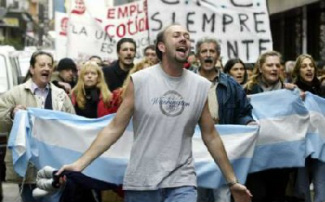 Argentinians protest economic policies of the IMF. Argentinians protest economic policies of the IMF. Tags: capitalism, economic sociology, globalization, political economy, social mvmts/social change/resistance, theory, argentina, deregulation, double-movement, embeddedness, karl polanyi, laissez-faire capitalism, neoliberalism, regulation, subtitles/CC, 00 to 05 mins Year: 2004 Length: 5:30 Access: YouTube (start 3:05; end 8:35) Summary: In his famous book, The Great Transformation, Karl Polanyi argued that, throughout human history, economic decisions have always been embedded within society (i.e., they have been shaped and constrained by social values and relationships). However, with contemporary capitalism, the economy has become disembedded from society through laissez-faire capitalism, which is promoted by many liberal economists and capitalists, and meant to disregard social factors. While this system has created tremendous wealth, it is unable to regulate itself and is not a "natural" economic order, as its proponents claim. In actuality, if laissez-faire capitalism is left to itself, it creates so much social dislocation that it would destroy itself, and thus it inevitably sparks resistance to it. This resistance leads to movements to regulate capitalism to varying degrees, from reforms that put constraints on capitalism (e.g., the New Deal) to more radical changes to the capitalist structure (e.g., socializing the economy through a centralized state), thus re-embedding the economy within society. This excerpt from the documentary, The Take (start 3:05; end 8:35), illustrates this double-movement between efforts at regulation and de-regulation. With a focus on Argentina, it shows how systematic deregulation in the 1990s, and the problems it created, sparked massive resistance. The deregulation (which itself required state action) included selling off public assets, eliminating currency controls, and implementing a variety of business-friendly policies. Supported by the IMF, these neoliberal policies crashed the economy in 2001, resulting in massive unemployment and poverty rates exceeding 50%, which sparked spontaneous protests throughout the country. Like similar double-movements throughout the world, the resistance sought to re-regulate the economy, and re-embed the economy in society, to meet vital social needs. The rest of the documentary shows that, in this case, the social response included a movement of workers that occupied and began running factories on their own. Submitted By: Paul Dean
2 Comments
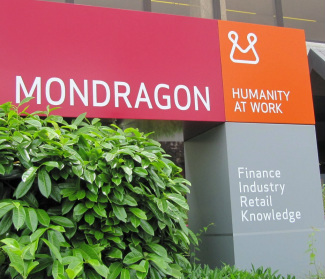 Mondragón is the largest coop network in the world. Mondragón is the largest coop network in the world. Tags: capitalism, economic sociology, marx/marxism, organizations/occupations/work, theory, cooperatives, market socialism, real utopias, 00 to 05 mins Year: 2012 Length: 5:04 Access: YouTube Summary: Mondragón Cooperative Corporation (MCC) is the world’s most famous cooperative organization and the largest and most successful network of cooperatives. Located mostly in the Basque region of Spain, MCC is a network of more than 200 individual cooperatives working across several sectors. It consists of about 80,000 workers (80% of which are owner-members). As shown in this news clip, this cooperative network functions very differently from capitalist organizations in the following ways: profits go to the workers, unemployed workers are transferred to other coops in the network to maintain stable employment, profits of one coop can be used to keep struggling coops operating in times of crisis, workers participate in decisions affecting their lives, and pay scales (i.e. income inequality) are much lower than in capitalist firms (this article systematically addresses these differences). MCC has helped its region have lower unemployment than the rest of Spain, has expanded globally, and fosters a culture of innovation and participation in a competitive market (although it has suffered some setbacks recently). In an era where statist societies with centrally planned economies have failed, some view MCC-style networks as a viable alternative to capitalism, or as a “bridge to a new socialism.” It illustrates Erik Olin Wright's concept of real utopias, which are "utopian ideals that are grounded in the real potentials of humanity ... [including] utopian designs of institution that can inform our practical tasks of navigating a world of imperfect conditions for social change" (2010: 6). This cooperative market economy also suggests what a broader society of “market socialism” might look like because it consists of collectively owned and controlled means of production, where economic decisions happen through markets rather than central planning. However, some criticisms about MCC from the left are markedly missing from the video (e.g. over time, MCC has appeared more capitalist by hiring more temporary employees, acquiring capitalist subsidiaries, some power has shifted toward experts, and two of the most successful cooperatives have left the network). Nonetheless, it remains significantly different from contemporary capitalist firms. For similar projects, see the movement of recuperated businesses in Argentina, the Cleveland model inspired by MCC, and other examples of workers’ control. Submitted By: Paul Dean 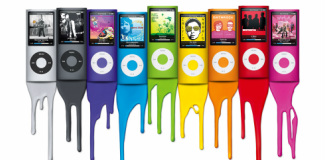 Apple attaches playful and whimsical meanings to its brand. Apple attaches playful and whimsical meanings to its brand.
Tags: capitalism, consumption/consumerism, corporations, culture, economic sociology, marketing/brands, marx/marxism, media, theory, apple, commodity fetishism, emotional branding, enchantment, 00 to 05 mins
Year: 1998; 2008; 2011 Length: 0:30 Access: YouTube (clip 1; clip 2; clip 3) Summary: Branding plays an increasingly important role in contemporary capitalism. Marketing industry experts describe a brand as a vision, a vocabulary, a story, and most importantly, a promise, which consumers experience through ads and products. One form of this is emotional branding, and in his book named for this approach, Marc Gobé argues that understanding emotional needs and desires, particularly the desire for emotional fulfillment, is imperative for corporate success today. Consumers unknowingly experience emotional branding throughout Apple’s wildly successful marketing. Based on a content analysis of more than 200 Apple TV ads (1984-2013), Gabriela Hybel and I found various expression of Apples’ emotional branding. They inspire feelings of happiness and excitement with playful and whimsical depictions of products and their users. This trend can be traced to the early days of the iMac, as seen in an ad (clip 1) from 1998. A 2008 iPod Nano ad (clip 2) combined playful imagery and song. In a more recent commercial (clip 3), actress and singer Zooey Deschanel, known for her “quirky” demeanor, performs a playful spin on the utility of Siri. Commercials like these — playful, whimsical, and backed by upbeat music — associate these same feelings with Apple products. They suggest that Apple products are connected to happiness, enjoyment, and a carefree approach to life. In George Ritzer’s words, they “enchant a disenchanted world.” They open up a happy, carefree, playful world for us, removed from the troubles of our lives and the implications of our consumer choices. Importantly, for Apple, the enchanting nature of these ads and the brand image cultivated by them act as a Marxian fetish: they obscure the social and economic relations, and the conditions of production that bring consumer goods to us. Now more than ever, Apple depends on the strength of its brand power to eclipse the mistreatment and exploitation of workers in its supply chain, and the injustice it has done to the American public by skirting the majority of its corporate taxes. For additional analyses of Apple’s commercials, see how they promote sentimentality, cool youthfulness, and the promise of social mobility. Note: this post was adapted from Dr. Cole’s original blog post at SocImages. Submitted By: Nicki Lisa Cole, PhD  West discusses his notion of the "habitual vision of greatness." West discusses his notion of the "habitual vision of greatness."
Tags: capitalism, commodification, consumption/consumerism, marx/marxism, social mvmts/social change/resistance, theory, alienation, commodity fetishism, conspicuous consumption, false consciousness, thorstein veblen, 00 to 05 mins
Year: 2004 Length: 5:32 Access: YouTube Summary: In this conversation between Dr. Cornel West and Tavis Smiley, West summarizes his thoughts on the “habitual vision of greatness,” or basing one’s life goals in altruistic motivations and behaviors. After discussing this vision from both religious and non-religious viewpoints, West goes on to distinguish between “success" and "greatness.” In contrast to greatness, he defines success as “pecuniary gain and financial prosperity” evidenced by “a big crib in a vanilla suburb.” Commodities become tools of division and alienation, and are fetishized by both the rich and the poor. This commodity fetishism leads people to believe that they are made human, and have a better chance of their personhood being noticed by others as they accumulate commodities. West emphasizes that this warped vision of success is directly tied to our market-driven, capitalist society. He concludes by citing the hope of Dr. Martin Luther King, Jr. and others as the foundation for leading a compassionate life, rather than a life driven by financial attainment. This video can be used in at least two classroom settings. First, in an Introduction to Sociology or Sociological Theory course, instructors can use the clip when discussing Karl Marx’s concepts of alienation, false consciousness, and commodity fetishism. This video can also be used to stimulate conversation around Thorstein Veblen’s conspicuous consumption, reflected in West’s dissection of monetary affluence flaunted with “a big crib in a vanilla suburb.” To incite discussion, instructors can ask students: What are media representations (i.e., Hollywood actors, reality TV, magazines, and advertisements) of commodity fetishism (and/or conspicuous consumption) that you see on a regular basis? Second, the clip can be used in a Contemporary Social Problems class when discussing remedies to social problems, specifically relying on West’s “habitual vision of greatness” as a potential starting point to think about social justice motivations and behaviors. Instructors can ask students: Why and how are feelings such as "hope," "compassion," and "love" important to theorize and research (and actually feel) when thinking about how to solve social problems? Submitted By: Beverly M. Pratt 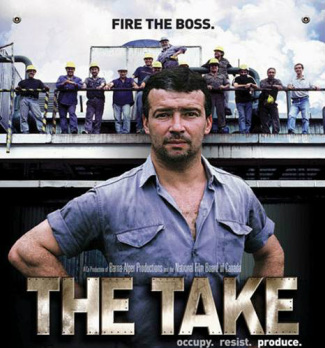 The Take documents factory takeovers in Argentina. The Take documents factory takeovers in Argentina. Tags: capitalism, class, economic sociology, globalization, marx/marxism, organizations/occupations/work, political economy, social movements/social change/resistance, theory, factory takeovers, labor, occupy, real utopias, worker cooperatives, subtitles/CC, 61+ mins Year: 2004 Length: 87:00 Access: YouTube Summary: This excellent documentary from Naomi Klein and Avi Lewis documents the extraordinary movement of factory takeovers in Argentina. As noted on the The Take's website, "In the wake of Argentina's dramatic economic collapse in 2001, Latin America's most prosperous middle class finds itself in a ghost town of abandoned factories and mass unemployment. The Forja auto plant lies dormant until its former employees take action. They're part of a daring new movement of workers who are occupying bankrupt businesses and creating jobs in the ruins of the failed system." By following the struggle of the Forja workers to regain control over its factory, it shows how workers formed networks and coalitions in their movement, the legal context of recuperated factories, the different organizational structures that workers develop to run their factories, the political reaction to neoliberalism, and the electoral race to shape Argentina's future. Accordingly, the movement serves as a unique bottom-up alternative to neoliberal capitalism. The film offers excellent illustrations of several sociological concepts, such as class consciousness and ideology. It also reflects Erik Olin Wright's concept of real utopias, which are "utopian ideals that are grounded in the real potentials of humanity ... [including] utopian designs of institution that can inform our practical tasks of navigating a world of imperfect conditions for social change" (2010: 6). As a "real utopia," the recuperated factories represent actually existing social projects that embody ideals of social justice, equality, and participatory democracy--they are not perfect (no social projects are), but they can serve as one model (of many) for what is possible. While the documentary was released in 2004, viewers may be interested to know that the movement of recovered factories continues in Argentina, including hundreds of workplaces and over 10,000 workers. For books on the movement of worker-run factories in Argentina, see Sin Patrón (2007) and The Silent Change (2009). There is also a recent (2013) example of one such factory in the US, Chicago's New Era Windows Cooperative. Submitted By: Paul Dean 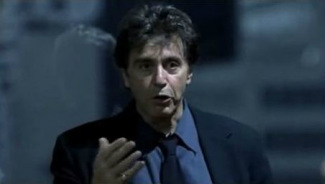 Al Pacino tries to save his story from corporate censorship. Al Pacino tries to save his story from corporate censorship. Tags: capitalism, corporations, knowledge, marx/marxism, media, political economy, theory, censorship, fox, ideology, monsanto, news, 00 to 05 mins, 06 to 10 mins Year: 2003; 1999 Length: 10:20; 4:17 Access: YouTube (clip from The Corporation) YouTube (clip from The Insider) Summary: This pair of excerpts exposes corporate censorship of the news via a documentary (The Corporation) and through a Hollywood film (The Insider). In recent years, the news media has become increasingly concentrated and controlled by corporations. The implications of this is that corporations are responsible to shareholders and must earn high profits. This concentration of corporate news has led to conflicts of interests when a news source wants to air a story that could hurt their advertisers or their shareholders. The first clip from The Corporation shows this process. In 1997, investigative journalists Steve Wilson and Jane Akre of Fox News, had prepared a story about Monsanto and the negative impacts of their bovine growth hormones (e.g. their milk was potentially carcinogenic to humans). Monsanto was an advertiser for the Fox News channel, and the company threatened to both sue Fox and pull their ads. Because this would have cost Fox News significant advertising revenues, Fox decided to edit the news story so Monsanto would not pull their ads. The clip describes the process of 83 rewrites that either removed or minimized any negative effects of the hormone, until the journalists were ultimately fired and the story never aired. The second clip, from The Insider, features Al Pacino arguing how a story at 60 Minutes was being censored because of financial interests. The film is based on a true story about a whistle blower who worked for Big Tobacco and CBS was hesitant to air the interview on 60 Minutes because it might jeopardize the sale of CBS to Westinghouse Electric. Both clips illustrate the political economy of news media and Marx's concept of ideology, in which ideas and knowledge reflect the interest of the ruling class. Marx argues that the class having the means of material production (e.g. technology, money, labor, tools, etc.) also has control over the means of intellectual production (newspapers, schools, books, broadcast media, etc). One can see Marx’s claim come to life with the influence that Monsanto had over Fox News. Corporate interests shaped what news was aired, and a Fox executive later told the journalists "the news is what we say it is"; when the journalists used the courts to fight back, a Florida appeals court ruled that falsifying the news is not against the law. In both cases, financial interests shaped what constituted the news, and how it was presented--ultimately shaping knowledge in the interest of the dominant class. Submitted By: Avery Winston and Paul Dean  Butters learns about class consciousness and privilege Butters learns about class consciousness and privilege Tags: class, inequality, knowledge, marx/marxism, theory, class consciousness, privilege, subtitles/CC, 00 to 05 mins Year: 2001 Length: 1:51 (00:00-01:51) Access: SouthParkStudios.com Summary: In his famous work The German Ideology, Karl Marx talks about class consciousness in the context of the proletariat (working class) and the bourgeoisie (ruling class). Class consciousness is the state of being aware of one's own social or economic rank in society, and privilege is "a special advantage or immunity or benefit not enjoyed by all." The American animated sitcom South Park is well-known for its humor, satire, and social commentary. In this clip, after Butters, Cartman, and Token present their science projects to the class, their teacher gives them each a grade for their projects. Butters receives a "check" for his fake volcano, Cartman receives a "check minus" for his taped together pen and pencil, and Token receives a "check plus" for his computer animated weather pattern predictor program that he showed from his laptop. After Token gets his grade, Cartman protests, criticizing Token's grade specifically and the check system as a whole. Cartman argues that, because Token is rich, he has access to more resources, enabling him to make a more sophisticated science project compared to the other kids in the class. The rest of the students agree with Cartman, knowing that their own lack of resources will inhibit them from getting ahead in the class. Aware that their socioeconomic status is holding them back, the students demonstrate class consciousness. Token is confused when his classmates call him rich, who cite the size of Token's home and Token's name brand clothes as evidence of his high class status. Token's confusion shows that he is unaware of his privilege, unable to see the numerous ways he has benefited from his socioeconomic status in society. Submitted By: Avery Winston 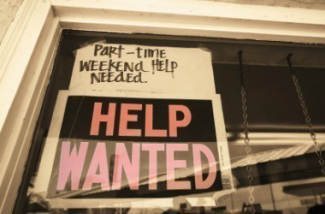 Part-time and other contingent work is on the rise. Part-time and other contingent work is on the rise. Tags: capitalism, class, economic sociology, inequality, marx/marxism, organizations/occupations/work, political economy, contingent work, cooperatives, flexible labor, temp work, 21 to 60 mins Year: 2012 Length: 25:24 Access: YouTube Summary: Contingent workers include part-time work, independent contractors, self-employed, agency temps, and on-call workers. In this segment of MSNBC's Up with Chris Hayes, Hayes discusses contingent work with his four guests from academia and worker advocate groups. After a brief introduction, the video focuses on contingent labor in the economy today (2:16-10:59) and moves to a more critical conversation of possible alternative worker organizations (11:00-25:24). It notes that contingent workers comprise 30% of the American workforce, which has increased dramatically in the last 10-20 years. It includes both low-skilled labor (e.g. janitors) and high-skilled labor (professors, computer engineers), who usually do not receive overtime pay, unemployment benefits, health care, etc. While some workers might prefer this relationship, it is mostly capitalists that benefit from this arrangement and the guests discuss the role of power in shaping contingent labor. They argue that business owners strive to maintain a flexible workforce, avoid providing benefits, and workers have much less bargaining power (through unions) today and have little control over this relationship. In the second portion of the segment, the guests discuss the desirability of this model and possible alternatives, especially worker cooperatives. The guests differ on if they see an inherent tension between employers and contingent labor, and viewers may reflect on how they believe work should be organized. If you prefer alternative arrangements, how would we get there? How does contingent labor fit into Marx's theory of capitalism and worker resistance? Submitted By: Paul Dean  Rapper Macklemore surrounded by Nike products and symbols Rapper Macklemore surrounded by Nike products and symbols
Tags: art/music, capitalism, commodification, consumption/consumerism, marketing/brands, marx/marxism, theory, baudrillard, commodity fetishism, exchange-value, labor, lacan, surplus value, signified, signifier, symbols, use-value, 00 to 05 mins
Year: 2011 Length: 5:33 Access: YouTube Summary: Seattle rapper Macklemore's music video for his thought-provoking song “Wings” is an excellent way to introduce students to Marx’s theory of commodity fetishism. Commodity fetishism is the process of ascribing magic “phantom-like” qualities to an object, whereby the human labour required to make that object is lost once the object is associated with a monetary value for exchange. Under capitalism, once the object emerges as a commodity that has been assigned a monetary value for equivalent universal exchange, it is fetishized, meaning that consumers come to believe that the object has intrinsic value in and of itself. The object’s value appears to come from the commodity, rather than the human labor that produced it. In “Wings,” Macklemore associates this process of commodity fetishism with Nike Air Max athletic shoes, explaining his belief as a child that the shoes would make him into a superstar athlete like Michael Jordan. The value of Nike shoes is displaced from the labour time that went into creating them, and instead is infused with an intrinsic value that comes into being through celebrity endorsement or symbols such as the iconic Nike “Swoosh.” “Wings” becomes a statement on how market capitalism seduces us into purchasing products that promise to make our lives better. Macklemore comes to this realization through the song’s narrative, exclaiming, “Nike tricked us all,” before finally realizing as the song comes to an end that “it’s just another pair of shoes.” Through tracks like “Wings,” Macklemore explores the darker side of consumption, urging listeners to critically rethink the messages imposed on us in capitalist societies that make us feel the need to constantly consume. This video can also be used to teach and distinguish among Marx's notions of use-value and exchange-value, as well as his concept of surplus-value, which is the surplus or profit earned by the capitalist, above and beyond the use-value (labour power) required to produce the object. Viewers may be urged to identify the use-, exchange-, and surplus-values of the Nike shoe in the video. How is value made? Why do we pay $180 for a pair of Nike shoes, but only $20 for a pair of Sketcher shoes? In addition, this video bolsters discussion about the power of symbols and signification (and Baudrillard’s notion of sign-value) in creating cultural meaning embodied in a commodity sign (e.g., the Swoosh on the Nike shoe, or the Apple symbol on an iPhone). Instructors can ask students to name other symbols in popular culture and what they mean to them. Drawing upon Jacques Lacan’s idea of the signifier and signified, instructors can expand the discussion of symbols by asking students to discuss the role of brand symbols in their life. Have they become a part of their identity? Their culture? Their daily lives? In the end, Macklemore speaks to this point: his Nikes are “so much more than just a pair of shoes.” They are “what I am… the source of my youth… the dream that they sold to you.” For another post on The Sociological Cinema that uses Macklemore's music videos to teach sociological concepts, click here. Submitted By: Patricia Louie  Tags: capitalism, class, economic sociology, inequality, marx/marxism, political economy, social mvmts/social change/resistance, theory, class consciousness, exploitation, hegemony, ideology, 00 to 05 mins Year: 1998 Length: 1:14 Access: YouTube Summary: Disney's Pixar film, A Bug’s Life, follows the life of a young ant, Flik, who leads a rebellion against greedy grasshoppers that feed on food harvested by the ants. In this clip, Hopper, the head Grasshopper, berates one of his minions for suggesting that the grasshoppers give in to the demands of one ant. Hopper points out that one ant's actions may be miniscule in effect, but several ants acting in unified collective action can overthrow the entire system that allows the grasshoppers to live such a comfortable life of abundance. This clip can be used to stimulate discussion on several Marxian theories and concepts. For example, given that the grasshoppers rely on the surplus of the ants' labor to maintain their own way of life, it illustrates Marx's theory of exploitation. But as Hopper notes here, "those puny little ants outnumber us 100-to-1, and if they figure that out, there goes our way of life." So if the ants were to recognize their class interests in this system, thereby attaining class consciousness, they would be likely to organize and fight back against the exploitative grasshoppers. He further notes "it's not about food, it's about keeping those ants in line." Viewers may reflect on what Hopper means by this. Specifically, the grasshoppers cannot give in to one ant's demands and believe they are entitled to the food they harvested. They have to keep the ants from recognizing their right to the food, and therefore must maintain ideological control (i.e. belief in ideas that support the ruling class) over the oppressed ants. The film clip can also be used in illustrating social movements and inequalities in general because it provides a cogent example of collective agency and its possible relationship to individual resistance. Submitted By: Chris Hardnack |
Tags
All
.
Got any videos?
Are you finding useful videos for your classes? Do you have good videos you use in your own classes? Please consider submitting your videos here and helping us build our database!
|
 RSS Feed
RSS Feed
